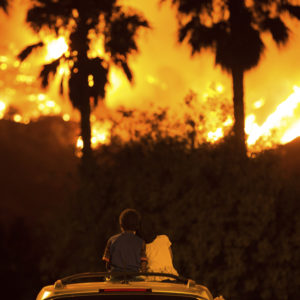Have the California wildfires of 2020 “set a record,” as state officials report? Only if you don’t look back too far.
What some are calling “unfathomable” today was commonplace in California’s past — and helps explain why America’s West Coast has a forestry management problem.
On Sunday, the California Department of Forestry and Fire Protection, or “CAL FIRE,” announced this year’s wildfires have burned 4 million acres, and the season isn’t over.
“The 4 million mark is unfathomable. It boggles the mind, and it takes your breath away,” said Scott McLean, a spokesman for CAL FIRE. “And that number will grow.”
But before 1800, California regularly burned this much acreage a year — or more — before modern control burn policies went into place. In fact, a report published in Nature Sustainability earlier this year argues California needs to burn 20 million acres of forest in order to restore forest health.
That’s the case made by a trio of climate experts during a press event earlier this month.
“Manmade policies — not manmade climate change — are what’s fueling these catastrophic fires,” said Myron Ebell, director for Energy and Environment for the Competitive Enterprise Institute.
Ebell, Heartland Institute President James Taylor and Steve Milloy, the founder of JunkScience.com, spoke on a media call for the national press to pushback against assertions that the wildfires are due to intensifying climate change.
So far this year, there have been dozens of large blazes — some reaching megafire status, which the U.S. Forest Service defines as an inferno that burns more than 100,000 acres. The August Complex Fire in Tehama County, California, burned 750,000 acres.
Environmental activists and scientists have pointed to the effects of climate change, including higher temperatures and increased drought for intensifying wildfires. For proof: Five of the 20 largest fires in California’s known history have occurred in 2020, according to CAL FIRE.
Taylor, however, noted that NASA satellites have measured a 25 percent decline in the amount of land burned by wildfires globally since 2003.
“The tragic irony is the very policies we were told were necessary to protect forests and wildlife are the direct cause of an uptick in recent wildfires,” Taylor said.
Since the 1960s, federal and state forest planning has been to do less, not more active management to cull trees, brush, and other growth. Legal action from environmental activists has also contributed to a lack of active management.
In the Sierra Nevada, which stretches through Northern California and parts of Nevada, lawsuits challenging environmental reviews have held up salvaging trees killed by bark beetles. The Timber Wars that began in the 1980s to place the northern spotted owl on the Endangered Species List worsened the tinderbox condition of public forests, Ebell said.
“If climate change were to blame, why does it only apply to publicly owned forests,” Ebell said. “The privately owned forests aren’t burning up.”
Up until 1990, the average cutting in national forests was 12 billion board feet of timber per year. After the spotted owl saga and other policies pushed by environmental activists, that dropped to about two billion board feet per year.
In Oregon, where 60 percent of the 30 million acres of forest are federally owned, wildfires have so far burned more than 1 million acres. Fully 10 percent of the state’s population is in evacuation zones, and at least two towns have been completely destroyed.
Gov. Kate Brown said more than 40,000 people have fled their homes with many still missing. The state has prepared for a “mass fatality event.”
A 2018 report from an independent California agency called for drastic changes in the state’s forest management policies. Two years prior, about 27 million trees situated on public and private lands had died, bringing up to 129 million the total number of dead trees during years of drought and bark beetle infestations since 2010, according to the U.S. Department of Agriculture.
And Professor Bjorn Lomborg, president of Copenhagen Consensus, writes before 1800, however, California typically saw between 4.4 and 11.9 million acres burn every year.
Only recently, though, has California stepped up forest management.
Last month, the state signed an agreement with the U.S. Forest Service to begin controlled burns and timber harvests — among other steps — across 1 million acres of state- and federally owned forests, which covers more than 57 percent of forest land.
Milloy pointed out that the wildfires have wiped out California’s emission-reduction efforts with the blazes releasing 90 million tons of toxic emissions from the smoke, which has reached the East Coast causing hazy skies.
“Seem to me that whatever you think the cause is, the only solution is manage the forest,” he said. “Otherwise, California will burn until there’s nothing left to burn.”

